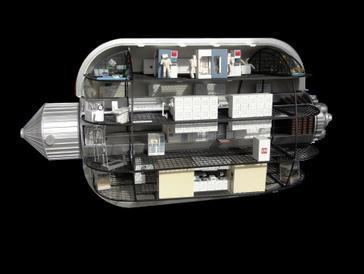Crew 16 Length 17.8 m (58.4 ft) Pressurised volume 2,250 m (79,000 cu ft) | Mission status Proposed Diameter 12.6 m (41.3 ft) | |
 | ||
Mass 65–70 tonnes (143,000–154,000 lb) | ||
The BA 2100, or Olympus, is a conceptual design for a larger, heavier, and more capable expandable space station module, or interplanetary human transport module, by Bigelow Aerospace. The larger BA 2100 would extend the volume and capabilities of the BA 330 module, which is under development as part of the Bigelow Commercial Space Station. As with the BA 330 module, the number in the name refers to the number of cubic meters of space offered by the module when fully expanded in space.
The weight of the BA 2100 could be as low as 65 to 70 tonnes (143,000 to 154,000 lb), but would more likely be "in the range of 100 metric tons". It is substantially larger than the BA 330, with the docking ends of the module alone estimated at approximately 25 feet (7.6 m) in diameter. The concept model showed the docking ports at both ends. The BA 2100 would require the use of a super-heavy-lift launch vehicle–and would require an 8-meter (26 ft) fairing for launch, such as the proposed Space Launch System, the Block II version of which would have a 130-tonne (290,000 lb) payload capacity.
Pressurized volume of single BA 2100 module is 2,250 cubic metres (79,000 cu ft), compared to 837 cubic metres (29,600 cu ft) volume of the whole International Space Station as of April 2013.
